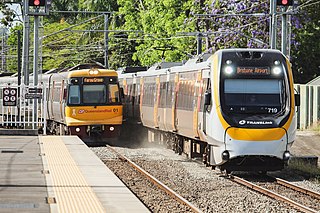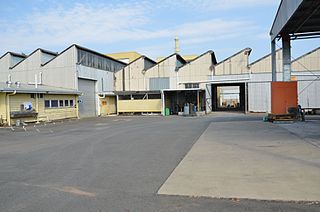
A Garratt locomotive is a type of articulated steam locomotive invented by British engineer Herbert William Garratt that is articulated into three parts. Its boiler, firebox, and cab are mounted on a centre frame or "bridge". The two other parts, one at each end, have a pivot to support the central frame; they consist of a steam engine unit – with driving wheels, trailing wheels, valve gear, and cylinders, and above it, fuel and/or water storage.

Queensland Rail (QR) is a railway operator in Queensland, Australia. Owned by the Queensland Government, it operates local and long-distance passenger services, as well as owning and maintaining rolling stock and approximately 6,600 kilometres (4,101 mi) of track and related infrastructure.

The Tasmanian Government Railways K class was a class of 0-4-0+0-4-0 Garratt locomotives operated by the Tasmanian Government Railways from 1909 – the first Garratt locomotives built.

The London and North Eastern Railway Class U1 was a solitary 2-8-0+0-8-2 Garratt locomotive designed for banking coal trains over the Worsborough Bank, a steeply graded line in South Yorkshire and part of the Woodhead Route. It was both the longest and the most powerful steam locomotive ever to run in Britain. It was built in 1925 with the motion at each end being based on an existing 2-8-0 design. The original number was 2395, and it was renumbered 9999 in March 1946, and then 69999 after nationalisation in 1948, although it retained its cab-side plate bearing its original number throughout its life. The locomotive ran for some time as an oil burner, and was tried out on the Lickey Incline in 1949–1950 and again, after the electrification of its home line, in 1955. These trials were unsuccessful, and so the locomotive was withdrawn in 1955 and scrapped.

The North Coast railway line (NCL) is a 1,681-kilometre (1,045 mi) 1067 mm gauge railway line in Queensland, Australia. It commences at Roma Street station, Brisbane, and largely parallels the Queensland coast to Cairns in Far North Queensland. The line is electrified between Brisbane and Rockhampton. Along the way, the 1680 km railway passes through the numerous towns and cities of eastern Queensland including Nambour, Bundaberg, Gladstone, Rockhampton, Mackay and Townsville. The line though the centre of Rockhampton runs down the middle of Denison Street.

The Australian Standard Garratt (ASG) was a Garratt articulated steam locomotive designed and built in Australia during World War II for use on the 1067 mm narrow-gauge railway systems owned by the Australian states of Queensland, South Australia, Tasmania and Western Australia. After the war, ASGs operated in South Australia and at the Fyansford Cement Works railway in Victoria.

Under the Whyte notation for the classification of steam locomotives by wheel arrangement, a 4-6-2+2-6-4 is a Garratt or Union Garratt articulated locomotive using a pair of 4-6-2 engine units back to back, with the boiler and cab suspended between them. The 4-6-2 wheel arrangement of each engine unit has four leading wheels, six powered and coupled driving wheels, and two trailing wheels.
Under the Whyte notation for the classification of steam locomotives by wheel arrangement, a 4-8-2+2-8-4 is a Garratt articulated locomotive consisting of a pair of 4-8-2 engine units back to back, with the boiler and cab suspended between them. The 4-8-2 wheel arrangement has four leading wheels on two axles, usually in a leading bogie, eight powered and coupled driving wheels on four axles and two trailing wheels on one axle, usually in a trailing truck. Since the 4-8-2 type is generally known as a Mountain, the corresponding Garratt type is usually known as a Double Mountain.

The New South Wales AD60 class were Beyer-Garratt patent articulated four-cylinder, simple, non-condensing, coal-fired superheated, 4-8-4+4-8-4 heavy goods steam locomotives built by Beyer, Peacock & Company for the New South Wales Government Railways in Australia.

The Queensland Railways C17 class locomotive are a class of 4-8-0 steam locomotives operated by the Queensland Railways.
Frederick Mills was Chief Mechanical Engineer of the Western Australian Government Railways from 1940 until his death in 1949. He was seconded to the Federal Government during World War II and was known throughout his career for designing a number of the influential steam locomotives for operation in Western Australia, including a number of controversial designs. No fewer than four Royal Commissions were held into various aspects of WAGR operations – including an examination of the safety of the Australian Standard Garratt locomotive and other aspects pertinent to its design and development – during his tenure, all of them into issues against which Mills himself fought unceasingly.

The Queensland Railways BB18¼ class locomotive was a class of 4-6-2 steam locomotives operated by the Queensland Railways.
In the late 1970s and 1980s, a significant rail electrification program was completed in the Australian state of Queensland. The electrified Queensland network is the largest in Australia with over 2,000 kilometres electrified, the next biggest is New South Wales with 640 kilometres, that is served mainly as passenger operations.

Queensland's railway construction commenced in 1864, with the turning of the first sod of the Main Line by Lady Diamantina Bowen, the wife of Queensland's first governor Sir George Bowen at Ipswich, Queensland, Australia. A narrow gauge of 3 ft 6 in was selected due to cost savings in providing a rail link to Toowoomba. Despite being built with bridges wide enough for standard gauge, and the fact that most other lines did not require heavy earthworks, the gauge remained the Queensland system norm.

The Queensland Railways AC16 class locomotive was a class of 2-8-2 steam locomotives operated by the Queensland Railways.

The South African Railways Class NG G11 2-6-0+0-6-2 of 1919 is a class of narrow gauge steam locomotives.

The Queensland Railways C16 class locomotive is a class of 4-8-0 steam locomotives that was operated by the Queensland Railways.

The South African Railways Class GMA 4-8-2+2-8-4 of 1954 is an articulated steam locomotive.

The Central Western railway line is a railway line in Queensland, Australia. It was opened in a series of sections between 1867 and 1928. It commences at Rockhampton and extends west 863 kilometres (536 mi) to Winton.

Rockhampton Railway Workshops is a heritage-listed railway workshop at 380 Bolsover Street, Depot Hill, Rockhampton Region, Queensland, Australia. It was built from 1915 to 1953. It is also known as Rockhampton Roundhouse. It was added to the Queensland Heritage Register on 21 August 1992.

















